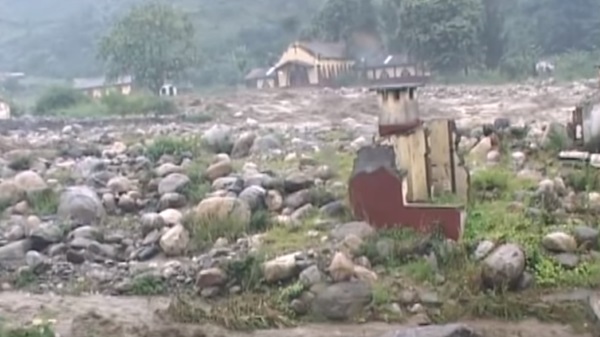River Nyamwamba one of the natural marvels of Kasese district traced its roots from the glacial peaks of Mt. Rwenzori from where it flowed swiftly through the towns of Kilembe and Kasese to which it offered much needed fresh water. However, once it burst its banks, Nyamwamba turned into Kasese’s worst nightmare. The river rushed through the riverside community carrying with it huge rocks and stones from the mountains as it destroyed everything in its path.
The people living on the banks of the river have come to live in constant fear of the damage it can cause. Barrier primary school stood on a ledge after part of it was swept away by river Nyamwamba in 2014. The school lost a whole classroom block and a toilet at that time but luckily no one died. Since then the pupils in primary three and four have been attending classes under a tree. “Every time whenever it rains we feel that it is coming again, we are always scared. And because of that our academic has been affected.”
As they endeavored to walk through the day with their heads high, the teachers and pupils at Road Barrier Primary School live in fear of another round of heavy rainfall which might cause the river to burst its banks again. “It has remained a scaring point because the children play near the affected part that washed away the building and also our toilet. And at the same time, the school is near that part that was washed away and the rocks, the stones, the silted materials are near the school which is a threat to our young children.” Said the Director of Studies, Road Barrier P/S, Sarapio Boosi Kule.
It was not only the school that was affected, even the neighboring communities especially in the Kilembe area were also affected. And of late Kasese had been affected by the heavy downpour and the debris which sometimes ended up blocking some access roads. One might wonder why river Nyamwamba had been bursting its banks more or frequently in the recent years and the immediate answer would be, a combination of climate change and increased human activity on the river. “You build near the river, you cultivate near the river when river floods as normally it is supposed to be doing, and it means you are bound to face trouble, you are bound to face the impacts out of that river flooding. What we need to do is to respect those river channels.” Said the District Environment Officer, Kasese, Augustine Kole.
At the beginning of October, hundreds of homes were destroyed in Kalambi Sub-county leading to the displacement of over 1,200 people. In August, the heavy rains that had been unpredictably common killed at least three children. Civil Society Organizations and district leaders have lately been helping the people of Kasese to rebuild their lives and find out ways of mitigating the effects of climate change. “So the way to mitigate the impacts of flooding of this river is one; for the government to come in and ensure that this original maintenance as it was originally designed when they were setting up the mines should consistently be done maybe every quarter. Two; I think there needs to be a community approach in terms of communities being involved, being part and part of the solution in terms of planting trees, encouraging natural regeneration and for them to understand that they need to stay 100 meters away from the river bank.” Said Vian Musika - Climate Change Adaptation, Save the Children.
For now, individuals, community leaders, Civil Society Organizations, local institutions and private organizations like NTV and Daily Monitor are helping to create awareness about climate change and its effects ahead of the International Day of Action on Climate Change, different stakeholders are also pushing initiatives to make sure that these disasters do not occur or to find viable solutions to mitigate their effects when they occur.

